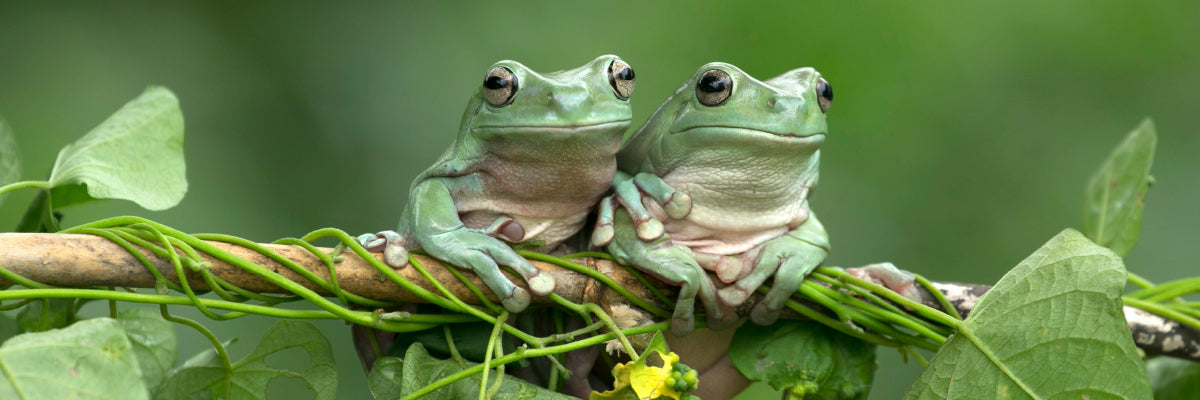Tree Frogs: The Tiny Acrobats of the Rainforest
September 27, 2024 • Grace Micere
>

There are 800 species of tree frogs that live on every continent except Antarctica. They are small, colorful amphibians known for their incredible ability to stick to just about anything. Tree frogs have jewel-like eyes and luscious, multi-colored, metallic skin.
In this article, we take you on a journey through the wonderful world of tree frogs. We reveal whether they are endangered and a few fun facts about them. We’ll also let you in on how you can contribute to saving tree frogs from extinction by simply buying socks!
Fun Facts about Tree Frogs
Tree frogs are wondrous little creatures that are full of surprises. We researched multiple species and compiled this comprehensive list of fun facts about tree frogs.
- They have striking red eyes - The red-eyed tree frog has bright red eyes that it uses as a defense mechanism. It pops its eyes open when it feels threatened, startling predators in a tactic called startle coloration.
- They have see-through skin - The glass tree frog has near-transparent skin. You can actually see its internal organs through its belly, including its beating heart.
- They are always in a sticky situation - Tree frogs have specialized toe pads that help them stick to surfaces. These pads secrete mucus that allows them to cling to all surfaces, including smooth, vertical ones like glass.
- They are jumping masters - Tree frogs are incredible jumpers. Some species can leap over 20 times their body length! That can be likened to a human jumping the length of a basketball court in one go.
- They are camouflage kings - Tree frogs are the chameleons of the frog world. Some species like the squirrel tree frog can change color to blend into their surroundings. This makes tree frogs nearly invisible among the leaves to avoid predatory danger.
- They have a stunning vocal range - Male tree frogs are known to sing for love. They use their calls to attract mates. Some species can be heard up to a mile away when they call. The louder and more complex the call, the more babes he attracts.
- They have great night vision - Tree frogs are nocturnal creatures and night vision is essential for their survival. Their eyes are adapted to detect movement in low light, allowing tree frogs to hunt insects at night.
- They are climate scientists - Tree frogs are bioindicators. This means that they can signal changes in the environment. A decline in tree frog populations may indicate issues like pollution, habitat loss, or climate change.
- They can fly - Some tree frogs can literally fly from tree to tree. For instance, the Wallace’s Flying Frog spreads out its large webbed feet and stretches out its limbs to catch the air.
- They lay eggs on leaves - Some tree frogs lay their eggs on leaves that hang above the waters. This is so that when the tadpoles hatch, they drop into the water below where they continue to grow and develop.
- Living the high life - Most tree frogs live high up in the rainforest canopy, hundreds of feet above the ground. They have developed long limbs and lean bodies to survive up there.
- They have species-specific calls - Each species of tree frog has its own unique call, which they use to identify one another. This helps them find mates and avoid calling out to the wrong species. In other words, that’s how they find the right soulmate.
Why Should We Care About Tree Frogs?
As mentioned earlier, tree frogs play a vital role in environmental protection. They are, therefore, important indicators of environmental health. Since they live in both water and land, they are effective at helping scientists notice changes in these habitats.
>

Tree frogs are natural pest controllers. They feed on various insects, including those that carry diseases that affect humans and other animals. Tree frogs, therefore, keep insect populations in check, help reduce the spread of these diseases, and protect crops from insect damage.
Tree frogs have unique adaptations that make them ideal for teaching people about biodiversity, conservation, and the interconnectedness of life.
Are Tree Frogs Endangered?
Most tree frog species are stable. However, some species like the spotted tree frog are critically endangered. It was flagged as critically endangered in 1994 by IUCN. The spotted tree frog was almost made extinct by the Australian bushfires that happened between 2019 and 2020. Only about 10 spotted tree frogs are believed to have survived.
>

On a positive note, 80 spotted tree frogs were released to the wild in February 2024 after a successful breeding program.
That said, our research into the world of tree frogs has shown us they are some of the most at-risk species on earth for extinction. Considering that they breathe through their skin, habitat destruction, pollution, climate change, and diseases greatly threaten their existence.
We would hate to see these beautiful creatures go extinct. So, at Bare Kind, we’re taking action! We’ll take you through our contribution to tree frog protection next.
Our Contribution to Tree Frog Protection
We donate 10% of the profit from our tree frog socks to the Rainforest Trust U.K. This donation goes into saving several other rainforest animals, including lemurs, gorillas, red pandas, toucans, and the famous black panther.
You can help protect these colorful wonders of the rainforest by simply buying some bamboo socks! Our green tree frog socks are warm, breathable, moisture-wicking, and animal-saving. They make the perfect gift for animal lovers. And since we’re talking about frogs, check out our purple and blue frog socks.
All our socks are made from bamboo fiber. Bamboo socks are as soft as cashmere but last much longer. They are engineered to conform to the contours of your feet, with highly elastic precision knit for a snug fit.
Get some matching pairs for yourself and your loved ones and use them as work socks, dress socks, bed socks, or even loungewear socks.
Wrapping Up
The 800 species of tree frogs are packed with fascinating features and unique adaptations. They are important bioindicators that help us identify potentially adverse environmental changes.
At Bare Kind, we make novelty socks from bamboo fiber and donate 10% of all our profit to 35+ charity partners. We are B-Corp Certified, use 100% plastic-free packaging, and are 100% carbon neutral. The bamboo itself is 100% sustainably grown and great for the planet.
In the past, our efforts have helped save 887 acres of tropical rainforest, fund 209 boxes of fish for penguins, adopt 12 giraffes, and so much more. You can be a part of the movement by buying the world’s most comfortable socks that save animals. It’s an easy but effective way to make a pawsitive impact from the comfort of your home or office.
Explore our wide selection of colorful bamboo socks. We guarantee you’ll find something for everyone in the family – kids, and adults alike!
Invalid Password





